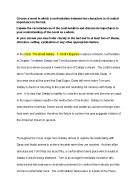The language Forster has used to discuss the funeral seems deliberate as the poor were the ‘only’ people that remained which is a credit to the memory of Mrs Wilcox as they have something in common, a connection to nature, but it’s disgrace to the rest of the family for the Wilcox family as they are of a high social class and to even be associated with those “abyss” was degrading. I somehow feel though that E.M Forster cannot write in great description of those who are poor as he said that every situation he had written about he had no personal experience of “the home life of Leonard and Jacky in Howards End.” In Forster’s opinion Mr Bast is stereotype of a poor person. Continuing on the Forster does not mention Mrs Wilcox’s name she is referred to as “the dead woman” a cold description emphasising the cold hearts of the Wilcoxes and stressing the importance of keeping the spirit of Mrs Wilcox present throughout the novel, in this case, representing her mysterious nature that her family could not relate to.
Even more so, the references to the lower classes emphasise the callus mind of the rest of the Wilcox family and how later on they handling of the letter proves this as they do not deal with feelings they are pragmatic for example the sarcastic comment about how ‘funeral of the rich was to them what the funeral of Alecestis or Ophelia is to the educated’
Supporting the evidence so far it is clear that Mrs Wilcox “knew no more of worldly wickedness than did the flowers in her garden” contrasting the rest of her family quite immensely, which is also proof that her family did not understand her beliefs- this is evident when they turn the pony stable into a garage for though there may not have been a pony in the stables the stable had sentimental value to Mrs Wilcox as this was her family home losing the traditional rural look and becoming more urbanised. Mrs Wilcox was a woman who transcended others and is described as trailing noiselessly, and the rest of the Wilcox family hadn’t noticed that Mrs Wilcox was infact a mysterious woman and though they felt ‘she had gone, and, as if to make her going the more bitter, had with a touch of mystery that was unlike her’ shows that there was a lack of personal relationship between the Wilcoxes.
Through opposition, Forster has shown the lack of emotion and how the Wilcoxes ignore their emotions. The imagery that has been used helps present the lack of connection to the Wilcoxes feelings and how they block them out through ‘fortresses’ and hiding their emotions explains their materialism without it their would be ‘panic and emptiness.’
When discussing the matter of the letter Mrs Wilcox’s name is never mentioned she is referred to as an ‘invalid’ which again shows the lack of connection to their mother and wife as they are impersonal and this should be a time of grief not for discussing the letter, especially in a business like manner which we can tell when “the two men were assuming the manner of the committee-room.’
‘The unseen had impacted on the seen, and all that they could say was ‘Treachery’.’ This shows that the formal men of the Wilcox family have a higher superiority of the women in their lives and their values cannot be tested, everything has to be logical and for things they do not truly understand, that are intangible like the sentimental values that Margaret and Mrs Wilcox shared there is perhaps in Charles’ eyes an alternate motive to Margaret’s intentions were “unduly” to manipulate Mrs Wilcox.
At the end of the chapter there is a metaphor that refer to the Wilcox’s avoiding their emotion and stop them from hearing reality “voyaged past the sirens, having first stopped one another’s ears with wool” both the Wilcox men are blocking out the emotion of how hurt they are by losing Ruth Wilcox but they are also blocking out the guilt from ignoring her last wishes of leaving Howards End to Margaret. Howards End was not just a house but to Mrs Wilcox it was her spirit.
However more to the point I have perceived Forster’s attitudes to the seen and unseen throughout chapter 11 and the rest of the novel to suggest that one cannot be without the other and that to make the world what it is they both are viewed by many people differently but are connected because it makes us all the individuals that we are.







